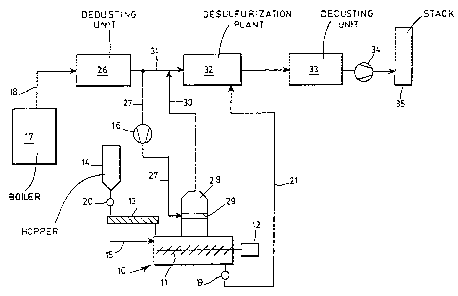Some of the information on this Web page has been provided by external sources. The Government of Canada is not responsible for the accuracy, reliability or currency of the information supplied by external sources. Users wishing to rely upon this information should consult directly with the source of the information. Content provided by external sources is not subject to official languages, privacy and accessibility requirements.
Any discrepancies in the text and image of the Claims and Abstract are due to differing posting times. Text of the Claims and Abstract are posted:
| (12) Patent: | (11) CA 1339241 |
|---|---|
| (21) Application Number: | 1339241 |
| (54) English Title: | CONTINUOUS PROCESS OF DRY SLAKING LIME |
| (54) French Title: | PROCEDE CONTINU D'EXTINCTION DE LA CHAUX AVEC ADDITION DE GAZ CHAUDS |
| Status: | Expired and beyond the Period of Reversal |
| (51) International Patent Classification (IPC): |
|
|---|---|
| (72) Inventors : |
|
| (73) Owners : |
|
| (71) Applicants : |
|
| (74) Agent: | ROBIC, ROBIC & ASSOCIES/ASSOCIATES |
| (74) Associate agent: | |
| (45) Issued: | 1997-08-12 |
| (22) Filed Date: | 1989-02-28 |
| Availability of licence: | N/A |
| Dedicated to the Public: | N/A |
| (25) Language of filing: | English |
| Patent Cooperation Treaty (PCT): | No |
|---|
| (30) Application Priority Data: | ||||||
|---|---|---|---|---|---|---|
|
In order to avoid a formation of
deposits and crusts in a continuous process of dry
slaking lime, wherein finely ground lime is mixed in a
slaking apparatus with water and hydrate of lime and
exhaust gas are withdrawn from the slaking apparatus,
it is proposed to admix hot gas-so that the
transformation from a humid to a dry exhaust gas will take
place within a much shorter time.
Note: Claims are shown in the official language in which they were submitted.
Note: Descriptions are shown in the official language in which they were submitted.

2024-08-01:As part of the Next Generation Patents (NGP) transition, the Canadian Patents Database (CPD) now contains a more detailed Event History, which replicates the Event Log of our new back-office solution.
Please note that "Inactive:" events refers to events no longer in use in our new back-office solution.
For a clearer understanding of the status of the application/patent presented on this page, the site Disclaimer , as well as the definitions for Patent , Event History , Maintenance Fee and Payment History should be consulted.
| Description | Date |
|---|---|
| Time Limit for Reversal Expired | 2006-08-14 |
| Inactive: IPC from MCD | 2006-03-11 |
| Inactive: IPC from MCD | 2006-03-11 |
| Letter Sent | 2005-08-12 |
| Inactive: CPC assigned | 1997-12-11 |
| Inactive: First IPC assigned | 1997-11-28 |
| Inactive: IPC removed | 1997-11-28 |
| Inactive: CPC assigned | 1997-11-28 |
| Inactive: IPC assigned | 1997-11-28 |
| Inactive: IPC assigned | 1997-11-28 |
| Inactive: First IPC assigned | 1997-11-28 |
| Inactive: IPC assigned | 1997-11-28 |
| Inactive: First IPC assigned | 1997-11-28 |
| Grant by Issuance | 1997-08-12 |
There is no abandonment history.
| Fee Type | Anniversary Year | Due Date | Paid Date |
|---|---|---|---|
| MF (category 1, 2nd anniv.) - standard | 1999-08-12 | 1999-07-13 | |
| MF (category 1, 3rd anniv.) - standard | 2000-08-14 | 2000-07-26 | |
| MF (category 1, 4th anniv.) - standard | 2001-08-13 | 2001-07-16 | |
| MF (category 1, 5th anniv.) - standard | 2002-08-12 | 2002-07-18 | |
| MF (category 1, 6th anniv.) - standard | 2003-08-12 | 2003-07-24 | |
| MF (category 1, 7th anniv.) - standard | 2004-08-12 | 2004-07-23 |
Note: Records showing the ownership history in alphabetical order.
| Current Owners on Record |
|---|
| METALLGESELLSCHAFT AKTIENGESELLSCHAFT |
| Past Owners on Record |
|---|
| DIETER GRONE |
| HARALD SAUER |
| ROLF GRAF |
| WENZEL VON JORDAN |